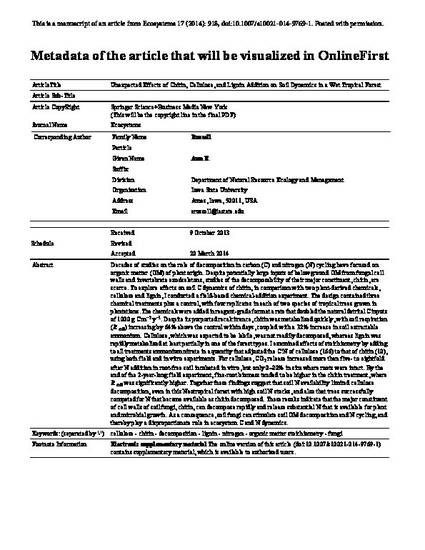
Decades of studies on the role of decomposition in carbon (C) and nitrogen (N) cycling have focused on organic matter (OM) of plant origin. Despite potentially large inputs of belowground OM from fungal cell walls and invertebrate exoskeletons, studies of the decomposability of their major constituent, chitin, are scarce. To explore effects on soil C dynamics of chitin, in comparison with two plant-derived chemicals, cellulose and lignin, I conducted a field-based chemical-addition experiment. The design contained three chemical treatments plus a control, with four replicates in each of two species of tropical trees grown in plantations. The chemicals were added in reagent-grade form at a rate that doubled the natural detrital C inputs of 1000 g C m−2 y−1. Despite its purported recalcitrance, chitin was metabolized quickly, with soil respiration (R soil) increasing by 64% above the control within days, coupled with a 32% increase in soil extractable ammonium. Cellulose, which was expected to be labile, was not readily decomposed, whereas lignin was rapidly metabolized at least partially in one of the forest types. I examined effects of stoichiometry by adding to all treatments ammonium nitrate in a quantity that adjusted the C:N of cellulose (166) to that of chitin (10), using both field and in vitro experiments. For cellulose, CO2 release increased more than five- to eightfold after N addition in root-free soil incubated in vitro, but only 0–20% in situ where roots were intact. By the end of the 2-year-long field experiment, fine-root biomass tended to be higher in the chitin treatment, where R soil was significantly higher. Together these findings suggest that soil N availability limited cellulose decomposition, even in this Neotropical forest with high soil N stocks, and also that trees successfully competed for N that became available as chitin decomposed. These results indicate that the major constituent of cell walls of soil fungi, chitin, can decompose rapidly and release substantial N that is available for plant and microbial growth. As a consequence, soil fungi can stimulate soil OM decomposition and N cycling, and thereby play a disproportionate role in ecosystem C and N dynamics.
Available at: http://works.bepress.com/ann_russell/12/

This is a manuscript of an article from Ecosystems 17 (2014): 918, doi:10.1007/s10021-014-9769-1. Posted with permission.